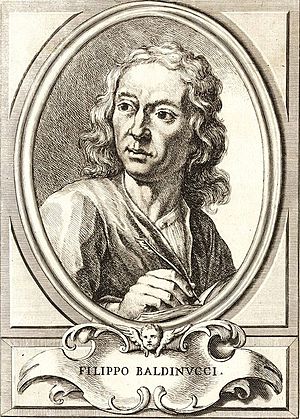Filippo Baldinucci facts for kids
Filippo Baldinucci (born June 3, 1625 – died January 10, 1696) was an Italian art historian and biographer. He wrote about the lives of many artists.
Baldinucci is known as one of the most important historians from Florence. He wrote about artists and art from the Baroque period. This was a time when art was very grand and dramatic.
Contents
Life of Filippo Baldinucci
The powerful Medici family supported Baldinucci. He wanted to be like Giorgio Vasari, another famous art historian. Baldinucci updated and added to Vasari's books about artists. He included artists from France and Flanders (now parts of Belgium and the Netherlands) that Vasari had missed.
His Most Important Work
Baldinucci's most important book was a dictionary of artists. It was called Notizie de' professori del disegno da Cimabue in qua. This means "News of the professors of drawing from Cimabue onwards." It started being published in 1681 and continued even after he died.
He also wrote a book about the famous artist Gian Lorenzo Bernini. This book was published in 1682.
Family and Talents
Filippo Baldinucci came from a rich and important family in Florence. Besides writing, he was also an artist himself. He drew portraits using chalk and made models from clay. Many of his lively chalk portraits of friends are kept in the Uffizi Gallery today.
Working for the Medici
In 1664, Baldinucci started working for Cardinal Leopoldo de' Medici. The Cardinal was the brother of Ferdinando II de' Medici, Grand Duke of Tuscany. He loved art and was a great supporter of artists. Baldinucci began as a bookkeeper for him.
After the Cardinal died, Baldinucci became almost like a curator for the Grand Duke's art collections. A curator is someone who manages and takes care of a museum's collection. Because of this, Baldinucci became known as one of Italy's top art experts.
Organizing Art Collections
Baldinucci did amazing work organizing and adding to the Medici collections. First, he worked on their drawings, then their paintings. He used new ideas for how to organize and complete these collections. This made them the most modern art collections of their time. Many of these collections later became the foundation of the famous Uffizi Gallery.
New Ideas in Art History
Baldinucci's careful work helped him tell the difference between the styles of different painters. This was a new idea back then. It helped create the field of "connoisseurship." This is the skill of judging art, especially for unsigned Italian drawings.
In his book called Vocabolario, Baldinucci created the first dictionary of art terms. He gave many definitions for different art styles. He even used some terms to describe "bad" art.
Expanding Art History
From this work, his Notizie book grew. He wanted to build on Giorgio Vasari's famous book, Vite. Baldinucci's book was the first art history book to cover artists from all over Italy, not just one region. Vasari had mostly focused on artists from Tuscany. Baldinucci also studied how great artists influenced each other's styles. He used careful research and old documents. This made him far ahead of his time in the study of art history.
In his Vocabolario (1681), he explained terms for fine arts. He also included terms for goldsmith work, pietre dure (a type of stone inlay), color pigments, and tools.
Religion and Art
In other ways, Baldinucci was very much a person of his time. This was the period of the Counter-Reformation and the Baroque style. He went to a Jesuit school and was very religious. Before getting married, he completed all of Ignatius of Loyola's Spiritual Exercises. He wanted to be sure if he should live a single life dedicated to God. Three of his sons became priests. One son, Antonio, was a Jesuit missionary who was later honored as "blessed."
Baldinucci loved the Baroque art style. He wrote in a style that matched it, with long, flowing sentences. He believed that art came from divine inspiration. He thought it was a gift from God to the special artists he wrote about.
Baldinucci's son wrote the first biography about his father. Baldinucci's own notes are kept in the Biblioteca Nazionale Centrale in Florence.
Works by Baldinucci
- Comminciamento e progresso dell'arte dell'intagliare in rame colle vite di molti de' più eccellenti maestri della stessa professione... (Florence 1667). This book was about the art of copper engraving. Baldinucci's own engraving was on the front. It was the first time Rembrandt's prints were mentioned in Italy.
- Vocabolario toscano dell'arte del disegno (Florence 1681). This was his dictionary of art terms.
- Notizie de' professori del disegno da Cimabue in qua, 6 volumes (Florence 1681–1728). This was his big biographical dictionary of artists. Some parts were published after he died.
- Vita del cav. Gio. Lorenzo Bernino, Lettera a Vinc. Capponi, Veglia sulle Belle Arti, Lezione accademica (1682). These works were collected and added to the second volume of his Notizie.
See also
In Spanish: Filippo Baldinucci para niños


